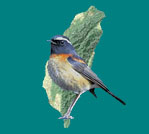 |
|
||||||||||||
|
|
|||||||||||||
 |
|
||||||||||||
|
|
|||||||||||||
|
Endemic Species White-whiskered Laughingthrush
Yellow Tit
Endemic Sub-Species
White-browed Shortwing
More Birds in Taiwan
|
Greater Painted-Snipe Rostratula benghalensis
This medium sized (23-28 cm) wading bird is unusual in several respects, and belongs to a distinct family with only two members in the world. In this species the female is more brightly coloured than the male: her head and neck are dark rufous, a white patch surrounds the eye, and a yellow stripe bisects the crown. The back and wings are dark green with very fine black bars. The underparts are clear white, with a stripe extending up the side of the breast and onto the mantle. The male has a golden eye-patch, crown-stripe and mantle stripe, and is grayish brown above, grayer on the head and neck; the sides are spotted golden yellow and buff. The legs of both sexes are yellow to greenish yellow, and the long , blunt-tipped bill is yellowish to yellowish-orange. The Greater Painted-Snipe frequents wetlands at low elevation, such as marshes, swamps, overgrown rice fields, and freshwater lakes with good grassy cover. It is omnivorous, eating a variety of invertebrates including insects, snails, worms and crustaceans, but also a variety of grasses, rice and millet. It may probe the soft ground with its bill, or sweep its bill back and forth through shallow water. It feeds mainly in the evening and perhaps also at night. The nest is built by the male, generally on marshy ground, and is usually well concealed in thick vegetation. The Greater Painted-Snipe is polyandrous: the females fight each other for territory and court the males; they will mate with several males in succession, usually laying three to five eggs from each mating. After laying a clutch, the female leaves the male to incubate the eggs and rear the young, and seeks another mate. In Taiwan the breeding season for Greater Painted-Snipes extends from April to July. They are resident year-round.
References: Handbook of Birds of the World Vol. 3; The Complete Guide to Birds in Taiwan (Jin-yuan Wang) |